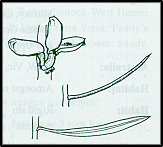South West Slopes Revegetation Guide
Hakea microcarpa
Small-fruited Hakea
Select from the following for detailed images.
Species Information
| Synonyms |
H. patula, H. bifrons, H. glabriflora |
| Common Names |
Small-fruited Hakea, Small-fruit Hakea |
| Family |
Proteaceae - Protea family. |
| Name Origin |
Hakea - after Baron Christian L. von Hake, 18-19th century German patron of botany. microcarpa - from Greek micro, small, and carpos, fruit, referring to small fruit. |
Specimen Data -
| Location |
|
| Notes |
No Specimen Data Available |
| Collector |
|
Date |
01/09/1997 |
| Determined By |
|
Date |
01/09/1997 |
South West Slopes Revegetation Guide Information
| Regional: |
Noted only in Munderoo district. Possibly also in surrounding areas in similar country. |
| Australia: |
Qld, NSW, Vic, Tas. |
| Habitat: |
Wet situations in dry sclerophyll forest and woodland, including streamsides and bogs, or heathy swamps, mainly at higher altitudes. |
| Habit: |
Small, rigid, open, spreading shrub to 2 m high. Cylindrical or flattened leaves 3-11 cm long on erect branches. |
| Similar Species: |
|
| Site Preference: |
|
| Characteristics: |
|
| Flowering: |
Creamy-white, spring-early summer. Conspicuous. |
| Seed Collection: |
Monitor closely as seeds shed 3-14 days after maturity. Ensure collection by securing nylon stockings or paper bags over seed pods. Large quantities generally available. |
| Propagation: |
|
| Regeneration: |
|
| Timber: |
|
| Shade and Shelter: |
Useful low-level cover in windbreaks in poorly drained sites. |
| Land Protection: |
Useful for improving drainage in wet sites. |
| Wildlife: |
Flowers are a food source for native insects. Foliage good refuge for small birds. |
| Ornamental: |
Attractive, particularly when flowering or with open fruits. Easily cultivated. Prune regularly to promote branching. |
| Other: |
|
Note: The following information presented is only a guide, as plant characteristics vary depending on provenance (the plant's locality).
| Site/Preferred Habitat : |
Creekbanks & swamps at higher altitudes |
| Rainfall(mm) : |
900 |
| Growth Rate : |
|
| Tolerates : |
frost |
| Resents : |
|
| Uses & Comments : |
windbreak; drainage improvement; wildlife; ornamental |
Return to Database List
